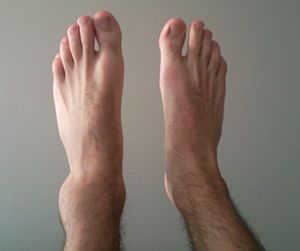 |
| Sprained Ankle (Photo credit: Wikipedia) |
Ankle injuries are common amongst dancers, so to stay in the game, so to speak, what can be done to protect this overtaxed joint and surrounding soft tissue? There are strategies for strength development and conditioning meant to reduce the risk of injury. The serious dancer is always in training in an effort to perfect their stance and form, allowing them to perform at the level that is demanded of them.
One of the most unattractive and weakest forms is when the foot is allowed to sickle. Instead of maintaining a straight line from the leg all the way through the foot, the foot is allowed to bend inward. It is unacceptable, unattractive and weak. This weakened position leads to ankle injuries like strains, sprains and breaks of the ankle.
The click on this link to go to a website that shows excellent visual of what a sickled foot looks like.
In order to prevent injuries caused by weak positions, the dancer must constantly be using exercises to gain strength and control. This is not a quick fix, but needs to be worked on consistently until sickling no longer occurs.
There are five recommended ways to prevent ankle injuries and a dancer would do well to heed the following advice:
- Warm up – the muscles of body, feet and ankles have to be prepared for work.
- Develop strong ankles and skills – dancers must have strong muscles and ankle strength in order to perfect ballet moves.
- Properly fit shoes and proper flooring – properly fit shoes are close and supportive. Too large a shoe allows the foot to come out of pointe and can result in injuries. Proper flooring is padded to protect from painful ankle injuries.
- The thin physique of the ballet dancer demands proper nutrition to maintain form and strength. Eat healthy and get the proper nutrients.
- When an ankle injury occurs, take care of it immediately with the proper rest and treatment. When you are ready to resume dance, wrap the ankle for continued support.
References:
http://www.livestrong.com/article/11170-prevent-ankle-injuries-ballet/
http://www.podiatrytoday.com/article/1616?page=1
http://dancers.invisionzone.com/index.php?showtopic=51274




No comments:
Post a Comment